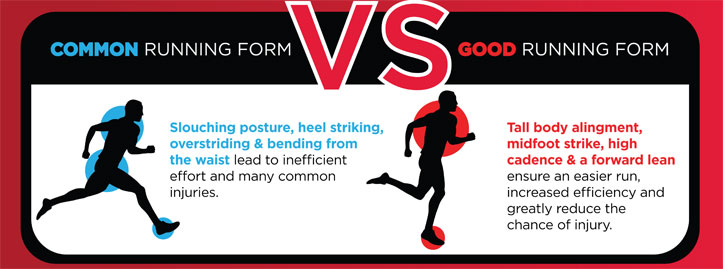Changing Your Running Style
Posted on by Ross HarrisA question I commonly hear in my clinic is “should I change my running style from heel-strike to mid or forefoot-strike?”. My initial recommendation is always do not change your running style just for the sake of it. If you’ve been running for years, and get few injuries you probably have a fairly efficient gait. If you have problems with recurrent injuries look at other factors that may be causing these such as insufficient rehabilitation or training errors (sudden increase in volume, intensity or type of training). Changing your running style is a slow process. When you change a movement pattern in your body it needs to be stored in your muscle memory so you can perform it without thinking, particularly when you are tired. To do this you must repeat the movement many times until it is ingrained in your brain. This takes a long time and in the short term your running economy may reduce as you have to think about how you run.
If you decide that poor running form is a significant causative factor in your injury woes then there are a few points to consider.
IS FOOT POSITION THE PROBLEM?
There’s more to it than foot position alone. Just because you heelstrike doesn’t mean you have bad form, though runners who heel-strike can often overstride. By moving your footstrike closer to the body a lot of runners will land on their midfoot, however, there are some that will still heelstrike, and that is fine. Likewise there are plenty of mid-foot strikers who overstride. So your focus should be on improving overall running form rather than worrying about your foot position on impact.
HOW DO I IMPROVE MY RUNNING FORM?
Here are 3 simple tips that will help to improve your running efficiency
1. Shorten your stride length
Land with your feet underneath your body rather than out in front. Your knee should be slightly bent. Focus on pushing off rather than pulling forward. You may find that initially you get muscle soreness as your gluts are working much harder than before!
2. Increase your cadence
The optimum steps per minute is 180, however this varies depending on the level of the athlete, and the intensity of your run. First, find your base level by counting the number of steps you take per minute when on an easy run, and then on a tempo run. Add 5% to these totals and these are your initial targets. So if your easy run cadence was 160, aim for 168. If your tempo run was 170 aim for 179. Take care, as upping your cadence too quickly can lead to injury.
3. Keep an upright posture
It is important when incorporating a slight forward lean into your running style that the movement comes from your ankles, and not your back. Don’t consciously try to lean forward, focus on running tall, with a straight posture, and once you shorten your stride a slight forward lean occurs naturally from the ankles.

Photo taken from https://angelajoynutrition.wordpress.com/2015/06/15/improve-running-form/


Leave a Reply